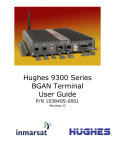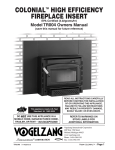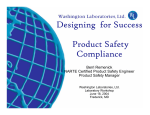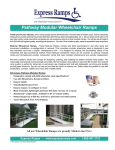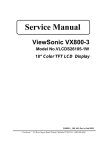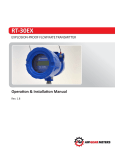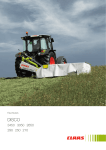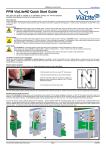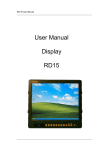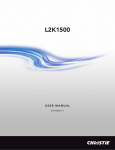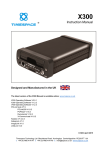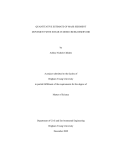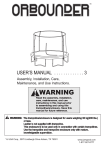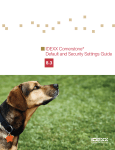Download T&EIssue16 - Washington Laboratories, Ltd.
Transcript
T&E Update/Issue16 1/31/02 12:31 PM Page 1 W A S H I N G T&E T O N L A B O R A T O R I E S , L T D Update Testing • Engineering • Consulting Issue 16 Tools of the Trade: Safety Design for Harmonized Compliance INTRODUCTION There are literally thousands of safety standards in use around the world. The good news is that harmonization allows the manufacturer to design a single product that complies with the requirements of numerous markets. The intent of this “Tools of the Trade” installment is to provide criteria that will assist designers working with the more common products on the market: Computers, Medical Devices, Machinery, Household Appliances and Home Entertainment Equipment. While this guide provides general and sometimes more detailed information, the reader is advised to refer to the standard that is applicable to his/her product for specific requirements. sidered hazardous. Currents that may cause harm are in the 10’s of microamps to 10’s of milliamps and the particular standard provides the limits. The frequency of the waveform of interest is also important; lower frequencies are more dangerous because they tend to travel deeper through human tissue and are more likely to affect the heart. Higher frequencies present greater danger of burns. Mechanical: Moving parts - required for correct function of the equipment or ancillary to it (fans, etc.) - present a physical hazard to the user of the equipment. Guarding, interlocking or other means should be provided to minimize the risks. Also, the likelihood that a product will tip over during use is considered during the evaluation. WHAT ARE HAZARDS? Many of us think of hazards as harmful to people. Hazards to the environment, animals and sometimes damage to the work-in-process are also considered. The following are generally considered when evaluating the hazards associated with equipment. Conditions of normal use, service and single faults or abnormal operation are reviewed as well. Heating: Excessive temperatures can cause burns, start a fire or degrade insulation within the equipment. The standards generally provide temperature limits for various internal and external parts. Installation or mounting methods are considered when evaluating the product: under-counter, installed in a cabinet, etc. Energy: The common PC power supply is very happy sourcing 25 amps or more at 5V. Even though the voltage will not hurt anyone, there is enough current available to melt insulation or start a fire under certain conditions. Current limiting is provided to reduce the risk of this hazard. Radiation: Lasers, RF emissions, audible noise, X-rays and other radiation sources are all potential hazards. The equipment design must reduce the risk of human exposure to these sources. Shock: This is the most widely-recognized hazard. Studies have been done to determine the voltages and currents which are hazardous to people. As a rule, voltages exceeding approximately 30Vrms, 42.2Vpeak or 60Vdc are con- Other Hazards: There is a tremendous variety of products on the market, each with unique characteristics and potential hazards. The applicable standards will usually address the hazards associated with the particular product or the risks will usually be recognized and addressed by product safety specialists. GETTING POWER TO THE UNIT Plugging In There are essentially three ways to get power to your product: Permanent wiring, fixed cord, and appliance inlet or plug/socket. There are specific requirements for each of these. (1) For permanent wiring (often found in industrial machinery), terminals are usually provided within the equipment. The terminals should be located close together and should be sized to carry the rated and anticipated fault currents for the particular product. Installation is often performed by an authorized individual in accordance with the electrical codes in force at the site. (2) Fixed cords (non-detachable) are often used in appliances. There may be several different options allowed by the standard, depending upon the complexity of cord replacement. These options may range from user replaceable to non-replaceable (that is, throw the device away if the cord is damaged). Requirements for fixed cords may include the type(s) of strain relief allowed, the type of cord and wire gauge required for a particular application and/or the maximum length of the cord. (3) Appliance inlets or plugs/sockets provide distinct advantages over fixed cords: appliance inlets are available with integral fuse-holders and means for voltage selection, and they can have built-in EMC filters. Inlets and plugs/ sockets allow easy changeover to cord-sets for different countries. Any inlets, plugs and sockets must bear approvals for the countries of intended use and must be rated for the particular application. continued on page 2 page 1 T&E Update/Issue16 1/31/02 12:31 PM Page 2 W Tools A S H I N G T continued from page 1 Sizing the Wires: Phase Connections Terminals and/or connections for Line and Neutral must be adequately sized (often dictated by the standard) and must provide adequate protection against loosening. Methods for providing such protection - often referred to as ‘double-securement’ - include: doublecrimp terminals, shrink-sleeving, cableties, lock washers, looping and hooking soldered connections, etc. The goal is to prevent a loose conductor from shorting against other parts or circuits. Protective Earthing (grounding for electrical safety) Earthing or bonding (often abbreviated PE-for “Protective Earth”) offers a level of protection by providing a path for fault currents which - by design - will blow a fuse or trip a circuit breaker. Some equipment may include a Residual Current Device (RCD), for Europe, or a Ground Fault Circuit Interrupter (GFCI) for the US. These devices detect fault currents and open the circuit as a fuse or circuit breaker would do. These are often used in damp areas and in medical devices where small, but lethal, leakage currents can flow. There are many requirements for PE. A primary requirement is that doublesecurement be used. The protection of PE connections must be taken care of at the terminations themselves. That is, a cable-tie or sleeving is not an option. Double-crimp terminals, lock-washers or hooking wires prior to soldering must be used. There are ‘fast-on’ connectors available which meet the requirements; these connectors provide a double-crimp which secures the insulation and conductor independently and have a ‘positive locking’ mechanism which prevents the terminal from sliding off by means of a tab and mating hole. A tool may be required to remove such a connector. PE must “make first” and “break last” when provided in a connector, for example, where an auxiliary outlet is available to plug in an accessory. Approved plugs and sockets will meet this requirement and many connector manufacturers now provide pins of different lengths to satisfy this requirement. O N L A B O R A T The current path must be robust. PE conductors and connections must provide a low-impedance path from all conductive surfaces to the supply earth. Bare metal-to-metal mating surfaces should be provided; this may mean that surfaces may need to be masked prior to painting. Also, attention should be given to the types of metals being used: dissimilar metals are subject to corrosion due to “galvanic action” or differences in electro-potentials. O R I E S , L T D requirements. A question that often arises is “What is the ratio of green to yellow?” Some, but not all, standards answer this: 30% of one color and 70% of the other. Further, it is recommended (and specified in some standards) that green OR yellow is not used ‘where there is a possibility of confusion’ (no, this does not apply to multi-conductor signal or other cables-the intent is to reduce confusion with the AC supply wiring). SMOKE¤ SOLDER¤ LUG GROUND WIRE¤ CHASSIS EMI FILTER CHASSIS CONNECTION TO OTHER GROUNDS MECHANICALLY SECURED GROUND: GREEN/YELLOW WIRE SAME GAUGE AS OR BIGGER THAN SUPPLY Terminal Markings Mark the terminals for the supply connections with “L” and “N,” for single-phase systems and with “L1, L2, L3” (for the US) or with “U, V, W” (for Europe) in three-phase equipment. PE is generally identified by the symbol • and/or by the letters ‘PE.’ Other terminals should be identified in the product and should correlate with the documentation for use and service. Alpha-numeric designations are usually acceptable. Some standards recommend specific colors for wires in other circuits, but there are few actual requirements beside the above. Do note that the customer may demand wire color standards to provide consistency for service personnel or for other site standards. The machinery standard mandates that all wires must be marked or identified in the product and the service documentation. Other agencies require replaceable cables to be identified, as well. Wire Colors and Markings In the United States, black and white are generally used to identify Line and Neutral (respectively). Brown and blue are the preferred colors in Europe for Line and Neutral (respectively). Wire colors will be correct in a cord which bears approvals for the intended market. ISOLATION FOR ELECTRICAL PROTECTION Protective Earth is usually green (US) or green/yellow (International) however, green/yellow can generally be used so that one model will meet most market Separation of Circuits One of the fundamental means of preventing hazards is to minimize the possibility of hazardous circuits coming in contact with other parts or circuits which, in turn, may be accessible to the user of the equipment. The means may consist of Creepage Distance (i.e., distance between two parts over a surface) or Clearance (distance through air). continued on page 3 page 2 T&E Update/Issue16 1/31/02 12:31 PM Page 3 W Tools A S H I N G T continued from page 2 Creepage and Clearance are also known as spacings. Spacings are measured by the shortest distance between bare conductive parts. Mounting hardware used to install PC boards (metal screws and standoffs) can reduce the spacings below acceptable values. Insulation may be used, either alone or in conjunction with spacings to provide the separation between circuits. The standard will identify the ways in which the separation may be provided as well as specific requirements for each method. Working Voltage One of the considerations for determining spacing requirements is Working Voltage. That is, the maximum voltage that the relevant insulation will be subjected to. The voltage is measured between any two points in the circuit (including voltages to ground). It is recommended that the derived Working Voltage should never be less than the supply voltage in a primary circuit regardless of the circuit configuration or the measured values. Further, periodic spikes that exceed the nominal value (e.g., switching spikes) are considered, but transient overvoltages are not. Installation Category Another factor that may be used to determine spacings is Installation Category. Where is the product installed in relation to the power source? Is it before or after the branch circuit protection? Is it connect- O N L A B O R A T ed to a low-voltage power supply? There are four Installation Categories that cover most products. Of these four, the vast majority of products fall under two: Category II is for equipment that is powered by 100 - 240V~ after the branch circuit protection and Category III covers low-voltage products such as keyboards, mice, etc. For example, in a notebook computer with a brick power supply, the power supply would be Category II, and the computer itself Category III. Pollution Degree Yet another consideration for determining spacings is Pollution Degree. This addresses where the product is to be used and what environmental conditions it will be subjected to. Circuits, components or products that are likely to be exposed to moisture or particulates in the air will require larger spacings than items that are encapsulated, used in a clean-room, etc. For example, take a look at the ventilation slots on a desk-top computer power supply; they’re likely to have ‘dust bunnies’ stuck to them. The build-up of dust and other solid matter is likely to cover the power supply board as well and may become moist on a humid day. Proper creepage distances are intended to reduce the possibility that a conductive track and short-circuit could occur. Proper clearances help assure that arcing between live parts will not occur. O R I E S , L T D Guarding Barriers or covers over hazardous parts can be used to reduce risk. Such guards can prevent access to high voltages, energy levels and mechanical hazards. The standards generally identify the requirements for guards, such as: • a tool must be required to remove the guard • sizes of openings do not allow access and • the guard must be attached in some way so that it can not be completely removed and misplaced Interlocks Interlocks operate to remove hazards prior to access. Interlocks disable electrical sources and/or mechanical hazards. Means for interlocking must be reliable - often, the switch or device must be cycle-tested. The interlock should consist of electro-mechanical components only and should not rely on logic circuits or semiconductors. An analysis should show that a single fault can not render the interlock circuit inoperable. Should it fail, it must fail in the safe mode (i.e., hazard locked-out). Other general considerations include: • all hazards must be removed before the cover can be opened • the interlock switch cannot be defeated by hand or without a tool • the door or cover cannot be closed with the switch defeated ENCLOSURES PROTECTION It is important to protect people, animals and the environment from harm. Electric shock, energy, fire, radiation and mechanical hazards are among the issues that are considered in setting safety design criteria. While the protection provided should not impair the function of the equipment, adequate safeguards should be in place to meet these safety objectives. Protection may consist of some or all of the following: Fusing Fuse protection will help prevent hazardous voltages from being accessible to the user (during a fault) or large currents being drawn by the equipment. Fusing and circuit protection are determined during the design phase as well as during fault testing where shorts and/or overloads will be imposed to ensure that hazards can not be created. Enclosures serve to prevent access to hazards as well as to contain fire. The standards outline a variety of requirements; for example, UL1950/EN60950 (Information Technology Equipment) specifies limits for sizes and location of openings plus the flammability ratings and thickness requirements for materials. Mechanical Strength Enclosures intended to prevent access to hazards must be strong enough to withstand anticipated environmental conditions. Hand-held products should not break open when dropped and other equipment should not create hazards if tipped over. Further, the enclosure must not bend or bow and reduce spacings or cause shortcircuits. Various tests are employed to evaluate the strength of enclosures, among them: steady forces and impacts are applied and drop tests are percontinued on page 4 page 3 T&E Update/Issue16 1/31/02 12:31 PM Page 4 W A Tools S H I N G T continued from page 3 formed. Following such tests, the product must remain safe in accordance with the standard. Flammability Plastic or other nonmetallic parts must not present a fire hazard. Most often, UL 94 ratings are acceptable for determining compliance with this requirement. Generally, parts with enough material to support and sustain a fire must not be flammable. PC boards may also have to be adequately rated; many boards are “94V-0” which meet most, if not all requirements. The required ratings are based on size, weight or mounting of the equipment along with quantities and locations of materials present. Be aware that the flammability rating is often based on material thickness and an enclosure may not meet the requirements because it is too thin. UL 94V-0 Least flammable UL 94V-1 UL 94V-2 UL 94HB Most flammable COMPONENTS “Safety-related” components must meet their relevant standards and must be used in accordance with their ratings. Such components include: • • • • • • fuses and fuse-holders power supplies and transformers circuit breakers relays supply connectors switches (in hazardous circuits) and terminals • wiring and terminals The component vendor will usually provide the information needed to use the part correctly. These parts will be identified and evaluated during the certification process, and changes that involve these critical components must be evaluated to ensure continued compliance. Buy Pre-Approved Parts It is always better to procure parts that already bear the required approvals. The components should meet the requirements in force in the intended market. That is, UL for the US, IEC or EN for Europe, etc. It is possible to use unapproved components and, many times, evaluate them in the end-product. Be aware, however, that you are responsible for the continued O N L A B O R A T compliance of those parts and must ensure that the component manufacturer does not make changes that affect safety. Get the certificate from the manufacturer– in the US it is a copy of the UL “yellow card” and elsewhere it would be a copy of an agency license or similar certificate. LABELING AND INSTRUCTIONS The standards identify the information that must appear on the product and/or in the manuals. General requirements are: • • • • the manufacturer’s name or rated voltage registered trademark current or power model number requirement and frequency • serial number or date code must be on the product Additionally, inputs and outputs, indicators and controls, and operator replaceable fuses should be marked. All markings should be identified and described in the manuals. INSTALLATION, USER AND SERVICE Instructions should be provided in manuals. The Installation Manual should include all information necessary to install the equipment. Examples are: supply connections (power, air, water, etc.), disconnect switches, over-current protection, ventilation requirements and other information appropriate for the particular equipment. The User Manual should contain all warnings and cautions along with all information for proper operation, cleaning, etc. The User Instructions MUST NOT direct the user to expose him/herself to hazards even when replenishing consumables or making adjustments. Language of User Instructions, as well as labeling, has always been a difficult topic. Generally, they should be in a language appropriate for the intended market. User Instructions for some product categories, such as household goods, must always be translated while others, like those for machinery, laboratory equipment or medical products may remain in English. Service Instructions should include all information required to maintain the equipment; replacement parts should be identified and any other special considerations should be explained. page 4 O R I E S , L T D CONCLUSION Presented here are merely fundamental issues affecting a product’s compliance with various safety standards. The reader is urged to procure the standard(s) appropriate for his or her equipment. Remember too that there may be more than one applicable standard; quite often, the primary standard will list a number of others (for components or other aspects of the equipment) and declaring or certifying compliance with the ‘base’ standard implies compliance with all. It is also feasible to create one product model that meets the requirements for a number of markets. Of course, labeling and language will change, but the basic construction of the equipment may not have to - just apply the more stringent requirements and look for ways to meet the intent of all standards. Remember that the standards generally tell you what to do but not how to do it, so, with a little effort, your design can be deemed to comply with all standards relevant to your product. In addition to an evaluation of a product’s physical characteristics, a number of tests are performed, among them: Dielectric Strength Humidity Preconditioning Insulation Resistance Enclosure Strength Leakage Current Sound Level Ground Impedance Heating Faults/ Abnormals And others, as specified in the relevant standard You can reach us at: WASHINGTON LABORATORIES, LTD. 7560 Lindbergh Drive Gaithersburg, MD 20879 301- 417-0220 800-839-1649 Fax: 301-417-9069 e-mail: [email protected] web: www.wll.com T&E Update/Issue16 1/31/02 12:31 PM Page 5 W A S H I N G T O N L A B O R A T O R GAITHERSBURG LAB MAY 17 AUGUST 16 NOVEMBER 8 FREDERICK LAB MARCH 15 JUNE 7 OCTOBER 18 Norman Violette will be the featured speaker at our Feb. 15 workshop with his popular discussion on "The Principles of Design for EMC. Washington Labs has announced its Free Workshop Schedule for 2002.These popular seminar/practical workshops will include demonstrations, guest speakers, the latest EMC and Safety compliance news, and lunch! Each workshop will have a specific theme and guest speaker! Be sure to register early as positions fill up quickly. Call Patty or Ann at 800-839-1649 to register today. EMC Testing and Measurements Hands-On Safety Compliance Designing to Avoid EMC Problems Down the Road Join us at our lab in Frederick for hands-on practical workshops to assist you with Product Safety Compliance. You'll not only hear and learn about the design tips and information to help you with new product design to ensure safety– but you'll roll up your sleeves and work with practical demonstrations and test simulations– all geared to provide you with a 3-D picture of designing for compliance. Watch as our Gaithersburg Lab engineers demonstrate several testing techniques that uncover EMC flaws in electrical and electronic equipment– problems which can be avoided before the testing stage. You’ll have the opportunity to “get specific” with the engineering staff on particular problems you may be encountering with current R&D designs. EMC and Military Standards Workshop E S , L T D Washington Laboratories Approved As UL Certificated Agency 2002 Testing Workshop Series FEBRUARY 15 I Washington Laboratories recently received notification from Underwriters’ Laboratories (UL) that the lab has been approved under the UL Engineering CAP. As a UL Certificated Engineering Agency, WLL can now perform UL testing without engineer-witnessing from a UL representative. They are currently approved for testing to UL60950 and UL1950 and additional standards will be added to the approval designation over time. Previously UL had to witness every test. This means WLL will have greater freedom in scheduling their clients and not be held to witnessing timing. “This is great news as it will greatly improve our level of service to our clients. No longer will we require UL in order to schedule and begin testing of products requiring compliance with domestic safety standards. The process will improve our turn-around time and limit redundant testing,” said Mike Violette, President of Washington Laboratories. WLL will be able to retest any failures without UL having to return for a second visit; therefore, non-compliance issues can also be resolved before any data is forwarded to UL. Additionally, UL and travel fees will decrease. Since the inception of MIL-STD-461, the evolution of EMC technology has rapidly increased. At the Washington Labs November workshop on EMC and Military Standards, speakers included Steve Ferguson, Washington Labs VP of Operations (left photo.) Steve led the discussion on MIL-STD-461E, which covers the requirements for electronic equipment to be sold to the Department of Defense. During the workshop practical session (right photo), attendees participated in test technique demos on EMC design, methods for making radiated and conducted meaurements, conducted and radiated susceptbility and EMP requirements. For more information on our 2002 workshops see the article above or give Patty or Ann a call to register at 800/839-1649. page 5 Per WLL Safety Manager, Berri Remenick, “WLL is now certified to perform testing under the CAP program at both the Gaithersburg and Frederick lab facilities. The time-to-market for our customers should greatly improve because of this new certification and streamlined process.” The process: ● WLL sends project request and proposed test plan to UL. ● UL approves test plan and provides cost limit. UL confirms if auditing will be required for that project. T&E Update/Issue16 1/31/02 12:31 PM Page 6 W A S Approved ● H I N G T continued from page 5 WLL performs all testing, completes UL report, sends test data and report to UL along with sample for construction review and auditing if required. ● UL reviews data and report, performs audit testing if required. UL issues approval. Washington Laboratories is a full service EMC and safety compliance testing facility with offices in Gaithersburg and Frederick, Maryland. For more information on this new certification or other services please call Berri Remenick at 301/417-0220. UNITED WE STAND O N L A B O R A T O R I E S , L T D Compliance Links American Telecommunications Certification Body, Inc (ATCB) americantcb.com The FCC has designated ATCB to issue Equipment Authorizations under Part 2.960 of 47 CFR (FCC Rules and Regulations). Prior to this program, the only route for product certifications was by submitting a formal application to the FCC for Equipment Certifications (including formerly-referred to applications called Type Acceptance). Under the TCB program, ATCB, under its accreditation by American National Standards Institute (ANSI), provides ISO Guide 65 Certification Services for electronic products requiring FCC Certification. National Technical Systems Corporation ntscorp.com (NTS) provides an extensive variety of integrated services, including testing, managed personnel and standards compliance. Washington Laboratories and NTS have signed agreements to work together in the area of Bellcore Testing and related NRTL approvals. Safety Link safetylink.com Website dedicated to Worldwide Regulatory Compliance. Syvax Design syvaxdesign.com Electronic product and systems developers specializing in state-of-the-art digital design. Technology International, Inc. techintl.com Competent and Notified Body for the European Union. Equipment Reliability Institute equipment-reliability.com Specialized technical training aimed at increasing the reliability of equipment. Example: Vibration and Shock Training. Regulatory Compliance Information Center rcic.com RCIC is designated to provide the updated compliance information to the compliance industry. The Reliability Center, Inc. reliability.com Reliability Consulting Services, Training Programs and Software Tools for Business, Government & Industry. The Northeast Product Safety Society, Inc. nepss.org Technical Presentations on EMC Immunity, Principles of IEC61010-1, North American Telecom Standards, Hazard Analysis, Demonstrations in Inductance, International Product Safety, Conformity in China, Product Safety Labeling, GR-63/Central Office Equipment, Restricted Substances, CE Marking Process, Understanding IEC60950, Hazardous Locations, Telecom Regulatory Update, International Approvals, Machinery Directive, Laser Safety and lots more to be announced.. Washington Laboratories, Ltd. Phone: 301- 417-0220 800-839-1649 Fax: 301-417-9069 e-mail: [email protected] Washington Laboratories, Ltd. 7560 Lindbergh Drive Gaithersburg, MD 20879 web: www.wll.com Presort Standard U.S. Postage PAID Permit No. 110 Frederick, MD 21701







